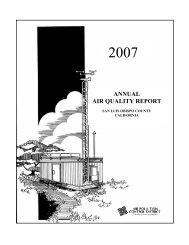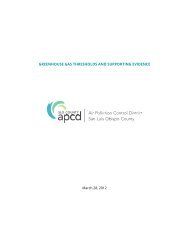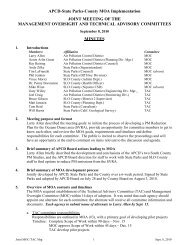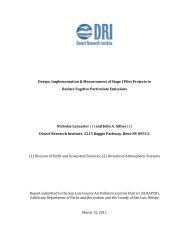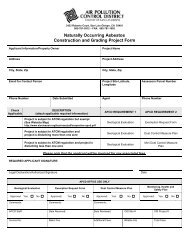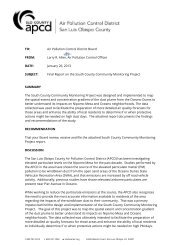CEQA Air Quality Handbook - Air Pollution Control District
CEQA Air Quality Handbook - Air Pollution Control District
CEQA Air Quality Handbook - Air Pollution Control District
You also want an ePaper? Increase the reach of your titles
YUMPU automatically turns print PDFs into web optimized ePapers that Google loves.
SLO County APCD <strong>CEQA</strong> <strong>Air</strong> <strong>Quality</strong> <strong>Handbook</strong> 2012<br />
1 PROJECTS REQUIRING AIR QUALITY REVIEW AND ANALYSIS<br />
The <strong>Air</strong> <strong>District</strong> has permit authority over many "direct" sources of air contaminants, such as power<br />
plants, gasoline stations, dry cleaners and refineries. Indirect sources are contributors to air pollution and<br />
include facilities and land uses which may not emit a significant amount of pollution themselves, but are<br />
responsible for indirect emissions, such as:<br />
• Motor vehicle trips attracted to or generated by the land use;<br />
• On-site combustion of natural gas, propane and wood for heating;<br />
• Architectural coatings and consumer products; and,<br />
• Landscape maintenance.<br />
Emission impacts from both direct and indirect sources are typically identified and, if needed mitigated<br />
through the land use planning process under the guidelines and statutes of <strong>CEQA</strong>.<br />
1.1 ROLE OF THE SLO COUNTY APCD<br />
Under <strong>CEQA</strong>, the SLO County APCD may act as a lead, responsible or commenting agency, reviewing<br />
and commenting on projects which have the potential to cause adverse impacts to air quality. The <strong>CEQA</strong><br />
statutes and guidelines require lead agencies to seek comments from each responsible agency and any<br />
public agency that have jurisdiction by law over resources that may be affected by a proposed project<br />
(<strong>CEQA</strong> 21153 and 15366). For many development proposals, this typically involves projects where<br />
vehicle trip generation is high enough to cause or contribute to local emission levels capable of hindering<br />
the APCD's efforts to attain and maintain health-based air quality standards. It is in this context that local<br />
jurisdictions and planning bodies can make critical decisions that affect their future environment and that<br />
of neighboring communities as well.<br />
Offshore activities within State waters, such as oil drilling and production, harbor dredging and cable<br />
installation are also subject to <strong>CEQA</strong> review and possible APCD permits depending on the nature of the<br />
activity.<br />
1.2 PROJECTS SUBJECT TO AIR QUALITY ANALYSIS<br />
In general, any proposed project with short-term construction emissions or long-term operational<br />
emissions that may exceed an APCD threshold of significance, as identified in this <strong>Handbook</strong>, should be<br />
submitted to the SLO County APCD for review. If needed, the APCD will assist in refining impact<br />
evaluations and or appropriate mitigation measures. The project will be evaluated to determine the<br />
potential for significant air quality impacts, with further analysis or mitigation recommended if<br />
appropriate. Types of projects which generally fall into this category include:<br />
• Discretionary Permits;<br />
• Tract Maps;<br />
• Development Plans;<br />
• Site Plans;<br />
• Area Plans;<br />
• Specific Plans;<br />
• Local Coastal Plans;<br />
• General Plan Updates and Amendments;<br />
• Large residential developments;<br />
• Large commercial or industrial developments; and<br />
• Remediation projects.<br />
1-2






